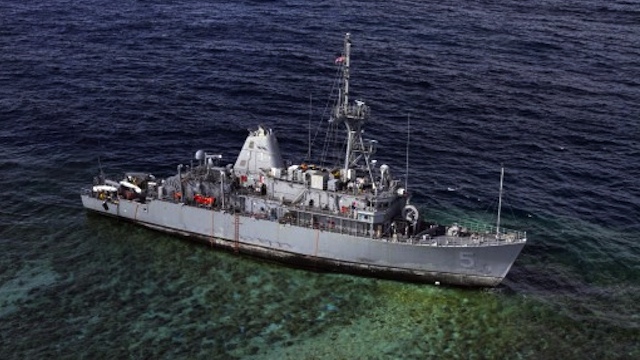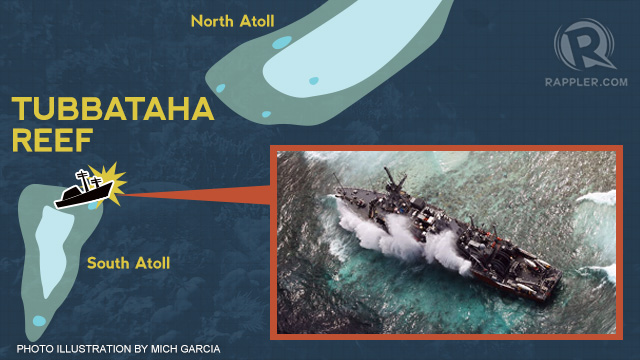SUMMARY
This is AI generated summarization, which may have errors. For context, always refer to the full article.

MANILA, Philippines – Preventing further damage to the coral is the top priority of the operation to extricate the USS Guardian from Tubbataha Reef Natural Park, the US Navy told Rappler on Wednesday, February 13.
“Mitigating damage to the surrounding environment has been a consideration throughout the process, and will continue to be as we remove [the USS] Guardian,” said Lt Frederick Martin, official spokesman for the US Pacific Fleet regarding the stranded minesweeper.
Martin stressed that immediately after the ship ran aground on January 17, the US Navy “worked meticulously to remove potentially harmful materials, including petroleum-based products and human wastewater.”
No fuel leaked and 15,000 gallons of diesel were successfully pumped from the vessel, the American officer added.
But removing the hull will be one of the most difficult parts of the salvage operation, currently suspended pending the arrival of the 2nd crane ship Jascon 25 after the 1st one, the SMIT Borneo, was unable to anchor in deep water at a considerable distance from the reef.
“Care will be taken while removing the hull itself, but the specific steps are still being developed,” Martin said.

2nd crane ship part of $25-M service contract
The Gibraltar-flagged Jascon 25 — currently on its way to Tubbataha from Japan and set to arrive on February 16 — is the 2nd floating crane that will be used in the salvage operation after the SMIT Borneo, on site since February 6.
The vessels belong to different companies but both are part of the same $25 million contract awarded by the US Department of Defense for private salvaging firms to remove the USS Guardian from the reef.
“Yes, both are part of the SMIT contract,” Martin confirmed.
The US Navy spokesman also explained that the Jascon 25 will be the lead vessel because it is equipped with a Dynamic Positioning System, “which means that it doesn’t have to lay anchors at all.”
“As a result, it will not face the same difficulties the SMIT Borneo did in securing itself before operating,” said Martin.
The new leading role given to the Jascon 25 is part of the revised salvage plan that Philippine and Americans authorities are still fine-tuning the process before it is published.

DOST offers help
Almost a month after the crash, the Department of Science and Technology (DOST) on Wednesday for the first time offered assistance to help mitigate damage in the UNESCO World Heritage site and paradise for divers.
“We can do something. We have the technology to help rehabilitate and repair the damage to the coral reef in Tubbataha,” DOST Secretary Mario Montejo said in a statement.
Montejo proposed sending a team of experts in coral reef restoration and using the department’s available technology to both work on the coral itself and train more Philippine Coast Guard and Maritime Police divers to do their job.
The estimated damage to the reef has reached at least 4,000 sqm, according to park officials.
The salvage operation is also expected to affect at least two dive sites to be closed off to the public during the official March-June diving season, unless the US Navy is capable of removing the ship by the target date of March 23 if weather and sea conditions are favorable.
Conservation groups such as WWF-Philippines have suggested leaving the vessel there to guarantee no more coral will be destroyed. – Rappler.com
Add a comment
How does this make you feel?
There are no comments yet. Add your comment to start the conversation.